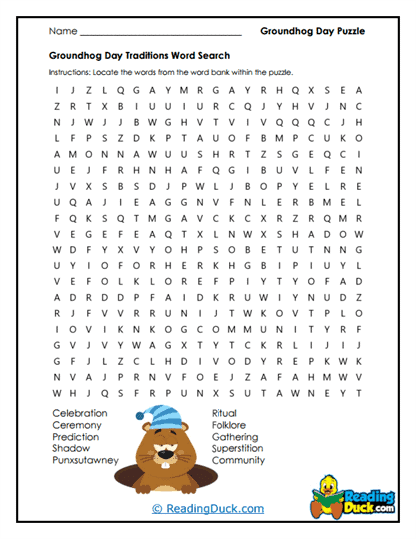Ground Hogs Day Word Searches Worksheets
About Our Ground Hogs Day Word Searches Worksheets
Related Worksheet Categories:
Ground Hogs Day Reading Worksheets
Groundhog Day word search worksheets are fun activities that help students learn about the traditions and vocabulary related to Groundhog Day. These worksheets usually include a grid filled with letters where students search for hidden words. The words often relate to Groundhog Day themes, like "shadow," "winter," "spring," or "Punxsutawney Phil." The activity blends education with entertainment, making it perfect for celebrating this quirky holiday in the classroom.
These worksheets are simple to use. Students are given a list of words and must find them in the jumble of letters. Words can be arranged in any direction, including horizontally, vertically, or diagonally. This variety keeps the activity engaging and gives students a bit of a challenge as they try to locate each word. The puzzles are not only fun but also a great way to introduce key terms and ideas associated with the day.
Teachers like to use word searches because they're easy to incorporate into lessons. They can serve as an introduction to Groundhog Day, a way to reinforce new vocabulary, or even a quiet activity during free time. By focusing on words tied to the holiday, these worksheets help students connect language skills with seasonal learning. They're also a great way to encourage curiosity about why Groundhog Day is celebrated and its history.
Students enjoy these worksheets because they feel like a game. As they find each word, they get a sense of accomplishment and pride. The activity is an excellent way to learn while having fun, and it provides a nice break from other types of classroom work. Plus, they're a great way to celebrate a unique holiday that doesn't always get much attention in school.
These worksheets are carefully designed to engage students with themes, vocabulary, and concepts associated with Groundhog Day. The collection includes both traditional word searches and clue-based puzzles, each emphasizing different aspects of the holiday, its traditions, and related science. Together, these activities provide a comprehensive and enjoyable way to blend cultural and educational learning.
One group of puzzles centers on the traditions and symbols of Groundhog Day. Worksheets like "Tradition Tracker" and "Symbol Search" introduce students to vocabulary associated with ceremonies, rituals, and iconic imagery like shadows and top hats. These puzzles emphasize cultural literacy by teaching about community gatherings, folklore, and the event's visual elements. Similarly, clue-based versions like "Symbol Clues" offer a more challenging way to explore these themes, requiring students to use descriptive hints to uncover words.
Another category focuses on the scientific and ecological aspects of Groundhog Day. Puzzles like "Behavior Basics" and "Biology Bits" highlight the natural habits and biology of groundhogs, introducing terms related to their life cycles, behaviors, and anatomy. These activities connect language arts to science, encouraging interdisciplinary learning and fostering curiosity about the natural world. The clue-based counterparts, such as "Clue Critters" and "Clue Anatomy," enhance critical thinking by challenging students to interpret hints about groundhog traits and ecological roles.
Weather and meteorology also play a central role in the collection. Worksheets like "Weather Words" focus on vocabulary related to weather prediction, such as "forecast" and "overcast," tying these terms to Groundhog Day's theme of seasonal change. Clue-based puzzles like "Clue Clouds" add an interactive layer, prompting students to deduce terms based on descriptions of weather phenomena. These activities enrich understanding of meteorological concepts while connecting them to cultural traditions.
Some of the worksheets celebrate the storytelling and cultural aspects of Groundhog Day. "Famous Furry" and "Groundhog Legends" introduce students to well-known groundhogs like Punxsutawney Phil and explore their roles in different regions. These puzzles link language learning with storytelling, enhancing comprehension and fostering curiosity about regional traditions and history. By focusing on famous figures and legends, these activities offer a playful yet educational approach to understanding the holiday.
Skills They Work On
Groundhog Day word search worksheets build vocabulary skills by introducing students to new words. For example, words like "forecast," "hibernation," and "shadow" help expand their understanding of language related to the holiday. Students also learn how to recognize these words in print, which improves their spelling and familiarity with the terms. By repeating this process, they strengthen their ability to identify and remember new words.
These worksheets also boost reading skills. When students scan the puzzle to find the hidden words, they practice their ability to focus on letters and patterns. This helps improve their visual recognition skills, which are essential for fluent reading. As they search in different directions, they develop their ability to track and interpret written information more quickly and accurately.
Word search puzzles encourage critical thinking, too. Students must use problem-solving skills to figure out where the words are hidden and decide how to approach the puzzle. They learn to look for patterns and think strategically about where to start. This helps build persistence and concentration, which are important for success in all subjects.
These worksheets are great for building confidence. As students complete each puzzle, they feel successful and proud of their work. This positive experience encourages them to engage more with reading and language activities in the future. Regular practice with word searches can make students more comfortable with complex reading tasks and foster a love for learning.









